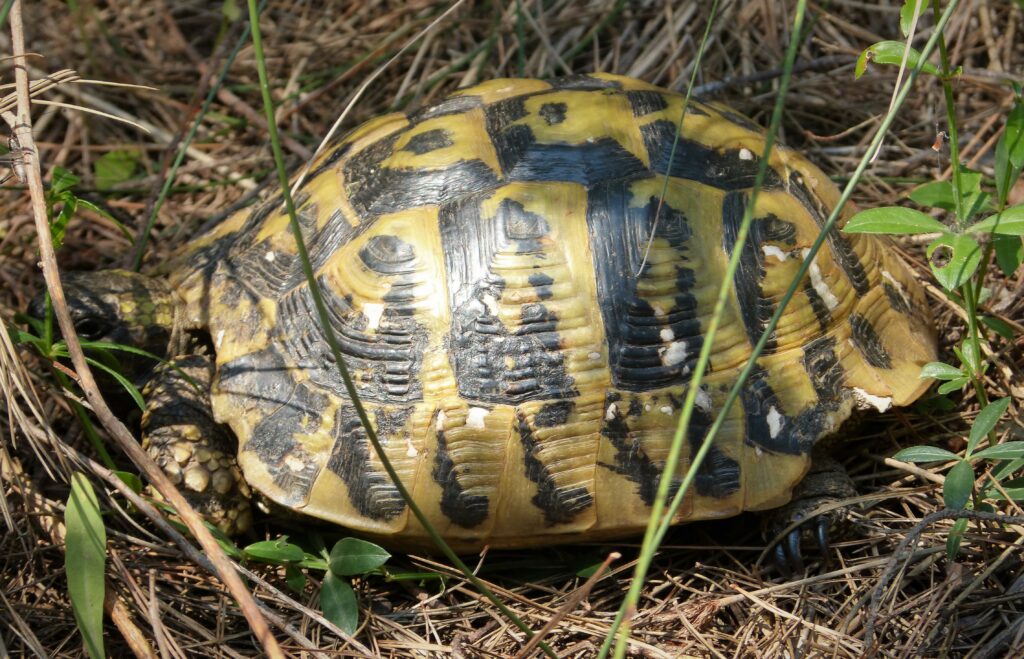
Image: Hermann’s Tortoise testudo hermani Wikimedia Commons CC 2.0
Tortoises! These slow and sturdy creatures fascinate humans with their remarkable skill of withdrawing into their shells. Can they really do it? Yes, they sure can! Their carapaces provide a protective cover. Tortoises retract their limbs and head inside the shell when they sense danger. It’s amazing how their muscles and ligaments help them fit snugly in the shell.
Surprisingly, turtles and terrapins also possess similar adaptations. But, each species might differ in terms of mobility and flexibility. Scientists have studied different species of tortoises to understand this behavior. An article in the Journal of Zoology revealed that some tortoises can even partially close off their shells.
So next time you witness a tortoise retreating into its shell, take a moment to appreciate the wonder of nature. It never ceases to amaze us with its intricate survival strategies.
Key Takeaways
- Tortoises have a unique ability to retract their head, legs, and tail into their shell for protection.
- Retracting into their shell is a defensive mechanism that helps tortoises avoid predators and potential threats.
- The ability to go into their shell is not limited to just physical protection; it also helps tortoises regulate their body temperature and conserve energy.
- Tortoises have a hinge on the bottom part of their shell called a plastron, which allows them to close their shell tightly.
- While tortoises can retract into their shell, they cannot completely close it off, as they still need to breathe and have limited mobility.
- It is important to provide tortoises with a safe and secure environment that allows them to retreat into their shell when they feel threatened.
- Tortoises should not be forced or encouraged to go into their shell, as it can cause stress and harm to the animal.
- Understanding the natural behaviors and needs of tortoises is crucial for their overall well-being and proper care.
What is a tortoise?
Tortoises are reptiles with hard shells that protect them. They can be found in deserts, forests, and many other habitats. They have a special ability to pull in their head, limbs, and tail.
These creatures belong to the Testudinidae family. This includes the Galapagos tortoise, African spurred tortoise, and desert tortoise. They move slowly and live long lives – some species live over 100 years!
Unlike turtles, tortoises spend most of their time on land. They have feet specially adapted for walking. Furthermore, their shells are dome-shaped to give them extra protection from predators.
Tortoises have been important throughout history. Ancient Egyptians held them in high regard and considered them symbols of fertility and life. People used their shells for divination due to their strength and patterned look.
The anatomy of a tortoise shell
The carapace is the outer layer of the shell. It’s made up of tightly fused scutes that form a strong, rigid shield. Each scute is unique in pattern and color, which serves as camouflage and helps with thermoregulation.
Below the carapace lies the plastron, which is flatter and smoother. It provides protection for the tortoise’s ventral side and vital organs.
Within the shell is an empty space called the coelom. Here, the tortoise can retract its limbs and head when feeling threatened or conserving energy. It cannot fully retreat into its shell like some other reptiles.
To ensure healthy shell growth, proper nutrition is essential. A balanced diet of calcium and vitamins is necessary. Cleaning and maintenance are also important to prevent cracks and infections. Gentle brushing with warm water and mild soap is recommended.
Creating an enriched environment with hiding spots and basking areas will allow the tortoise to exercise natural behaviors. Adding textures like rocks and logs will encourage physical activity and healthy skeletal development.
By understanding the anatomy of the shell and following these suggestions, tortoise keepers can provide optimal care for their shelled companions. The shell is critical to the tortoise’s overall well-being and deserves admiration and protection.
Can tortoises go in their shell?
Tortoises: marvelous creatures of nature with an extraordinary ability. When threatened, they retract their head, limbs and tail into their shell – a protective armor. This shell is made of bony plates covered by tough skin. It provides a sturdy shield and helps regulate their body temperature.
Yet, these slow-paced creatures can surprisingly retreat in seconds when sensing danger. Showcasing their instinctual survival skills honed over centuries. Ancient thinkers were intrigued by this defense mechanism. Aristotle documented extensive observations on tortoises and their shells. His keen observations paved the way for further scientific inquiry.
The only factor determining a tortoise’s ability to retreat into its shell is its level of introvertedness. So, if it’s a social butterfly, it might just have to stick its neck out and face the world head-on!
Factors that determine a tortoise’s ability to retract into its shell
Tortoises have the ability to retreat into their shells, and several factors play a role in this. Shell size and shape, flexibility, and muscular strength all affect how much a tortoise can withdraw. Some tortoise species even have special adaptations that let them securely shut off access to their bodies.
How can we help facilitate their ability to retract? We can create an environment similar to their natural habitat with enough space to move around and hiding spots like logs or rocks. Proper nutrition is also key for maintaining strong muscles.
Understanding these factors sheds light on creating an environment that promotes safety and well-being. With the right measures, we can help these amazing creatures thrive close to their natural state.
How tortoises retract into their shell
Tortoises are captivating creatures of the reptile realm, with an aptitude to withdraw into their shells for safeguarding. This innate defensive system permits them to safeguard themselves from probable threats.
A step-by-step guide on how tortoises accomplish this remarkable feat:
- Step 1: When feeling threatened, their muscles contract to start retreating into their shell.
- Step 2: As they proceed, they tuck in their head and limbs, pulling them inward towards their body.
- Step 3: The shell also plays an essential role in providing defense. It consists of a top part termed the carapace and a bottom part known as the plastron, surrounding the tortoise’s entire body.
- Step 4: Unlike other turtles that can completely close off their shells, tortoises have more limited mobility due to the joined anatomy of their shells. Though, this design still offers significant safety.
- Step 5: When fully retreated into their shell, tortoises can wait for long periods until they sense it is safe to come out.
Surprisingly, certain species of tortoises have evolved special adaptations. For instance, some possess an adjustable hinge ligament between their plastron and carapace, allowing them to partially open or close their shells based on the situation.
Tortoises are also known as “living fossils”, due to their ancient origin. According to National Geographic Society, these extraordinary creatures have been around for more than 200 million years!
By learning how tortoises withdraw into their shells and recognizing the wonders of their evolutionary traits, we comprehend the incredible world of these sluggish yet highly resilient animals. Wearing a tortoise shell in public may not be stylish, but it’s certainly a great way to evade uncomfortable conversations.
Benefits of a tortoise’s shell

The tortoise’s shell offers many advantages that make them one of a kind. It acts as a protective barrier, enabling them to hide from danger. This gives them an edge in different conditions.
- The shell keeps them safe from potential predators.
- It also acts as insulation from extreme weather.
- It helps them float in water.
- Plus, it stores nutrients for when food is scarce.
Plus, the intricate designs and colors on their shells improve their camouflage. Furthermore, some species have a hinged plastron, allowing them to tuck their heads and limbs in.
Tortoises have been around for a long time. Fossils of ancient species date back 140 million years. These creatures are fascinating to researchers and conservationists.
Fun fact: Some can live for 150 years or more in the wild.
The limitations of a tortoise’s shell
Tortoises’ protective shell is an evolutionary masterpiece that shields them from harm. But it comes with drawbacks. It’s heavy and bulky, making quick movements challenging. And it restricts them in tight spaces. Plus, predators can still target exposed spots. Also, extreme weather can be too much for the shell to handle.
To remedy this, we suggest creating enriched environments with ample space. This helps them exercise and move more freely. Also, providing additional hiding spots within enclosures lets them retreat without feeling too cramped. Lastly, careful predator-management strategies can minimize risks and still let them experience life fully.
Frequently Asked Questions
Q: Can tortoises go in their shell?
A: Yes, tortoises have the ability to retreat into their shells as a defense mechanism.
Q: How do tortoises go in their shell?
A: When a tortoise feels threatened, it contracts its muscles and pulls its head, legs, and tail into its hard shell for protection.
Q: How long can tortoises stay inside their shells?
A: Tortoises can spend extended periods inside their shells for as long as they feel threatened or until they perceive the danger has passed.
Q: Is it harmful to force a tortoise into its shell?
A: Yes, it is best to let tortoises retreat into their shells voluntarily. Forcing them inside can cause stress or even physical harm.
Q: Do all tortoises have the same ability to go in their shell?
A: Yes, all tortoises have a similar ability to retract into their shells. It is an innate characteristic of their species.
Q: Can a tortoise get stuck in its shell?
A: No, tortoises cannot get stuck in their shells. They have a flexible hinge that allows them to extend their body out when needed.
Conclusion
Can tortoises retreat into their shells for protection? Evidence suggests so! There are variations among different species though. Most can fully retract their head, legs, and tail, but some can only partially withdraw certain body parts. Shell shape and size vary based on the habitat and adaptations. For instance, tortoises in high-predator areas have thicker shells.
Ancient Rome believed a hand mirror would make a tortoise fully retract – though that’s been disproved! It’s amazing to consider how interesting these creatures have been historically.
References




